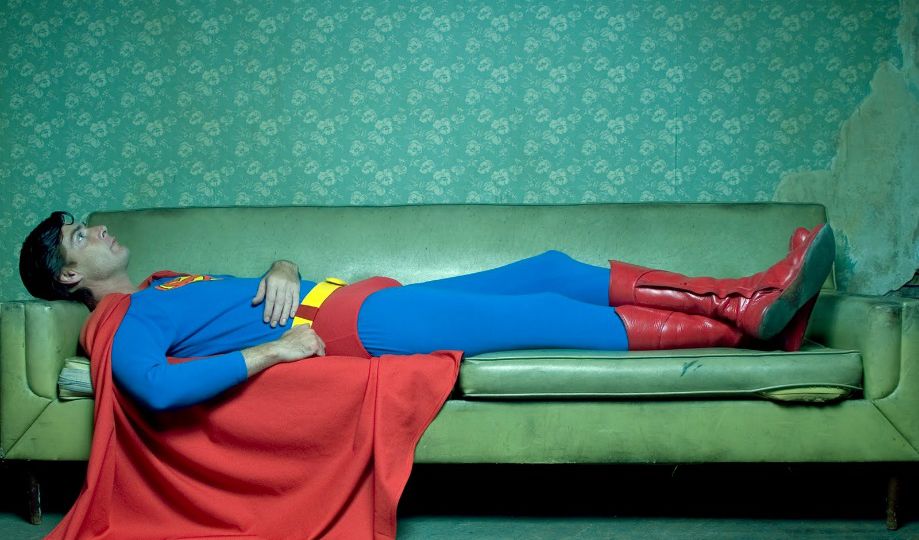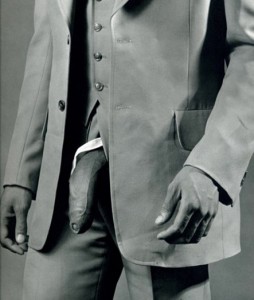
#1
My computer desktop features one of the most recognizable icons of 21st century (Western) popular culture: Superman, in his Christopher Reeve avatar. I found it randomly surfing through the Internet and can’t figure out which film this screen-shot is from. What is distinctive about this particular image of the icon of benevolent super-masculinity, is that Superman is not flying, or fighting the baddies, or saving the earth from destruction, or romancing someone. He is tired-eyed, in deep contemplation: lounging on a worn-out fawn coloured couch, in a room that has its blue wallpaper peeling off.
It is the most unlikely image of Superman that I have ever seen. On the face of it, I can read the image as: even Superman needs to rest and take a break. Interestingly though, even in its contemplative calmness, the image generates an erotic energy. Superman’s eyes seem transfixed on someone or something else outside the frame, an almost unattainable object/ subject of desire, somewhere out there. The framing of the image is such that you are able to follow in great detail the contours of his body. This is Superman from the days when you did not have body-sculpted suits that give hyper-masculine ripples to the abs and biceps and thighs. So what you see, is what there is. The chest is flat, and right below the yellow belt, the mound of his genitals looks accentuated under the famous red underwear that he wears over his blue bodysuit. Can it be an imminent erection prompted by the conversation that he’s having with his eyes (and body) with the invisible muse?
Superman, in this image, is in a position of benign submission. This is not the image of desirable masculinity – be it hetero- or homo-erotic – that Superman has been abundantly endowed with in popular culture – fast, strong, brave, in-control. This is the everyday Clark Kent – quiet, affable, modest – may be feeling shy (and somewhat ridiculous) about having to put on a Superman costume for a party. For me, this is a powerfully ‘queer’ image that turns Superman-like masculinity on its head. It does not subvert it necessarily, but allows for a counter-sexual reading of masculinity. It both sexes up Superman, and de-sexes the popular wisdom about his masculinity. When I start up my computer every day, my encounter with this image on my desktop, is a comforting reminder, that Superman’s masculinity can be imbued with a quotidian eroticism that even I can aspire to by lying on my decrepit couch (with my curvy abdominal bulge, and without the costume!).
Okay now, stop, someone will tell me. This is just pure indulgence. You can read whatever you want to in an image. So what’s the point? The point, really, is about indulging in that indulgence. And there’s nothing like popular culture that allows for such indulgence, making irreverence and sacrilege political and fashionable. Popular culture can really never be understood solely from the objective of the image creator. The way images of popular culture virally circulate and are collectively devoured in the ever-proliferating marketplace of visuality, requires that in our reading of images of popular culture, we take the idea of its affects seriously. An image, photographic or textual, is not just what you see – it is also about the intensities that the image generates when looked at, from different angles, at different times of the day, in different moods, with different people, publicly and privately. A reading of images of popular culture that pays attention to these intensities, is what I would understand, as one method of queering the image.
And, why do we need queering? We need queering, as J.K. Gibson-Graham reminds us, to be able to “read for difference rather than domination.” Or in other words, to read for domination when it is masked in the language of difference. To infuse sexuality into our readings of popular culture, thus, is not just about making things naughty – which is great and necessary – but as Jeffrey Weeks has noted, sexuality is a “focus for powerful feelings.” Queering then is about invoking powerful feelings by building the possibilities for a different reading of popular culture that can counter both the authorial objective and the consumptive logic of the image in question. This process of reading can both celebrate the transformative eroticism of otherwise sexually sanitized images, or it can reveal the hetero-dominative subtexts in what is framed as a sexually progressive image.
My purposefully indulgent queering of the Superman image was meant to be a (quick and dirty) preface to the reading of an advertisement that offered a fascinating insight into race-caste-sex politics in India. I look at an advertisement because it is the most ubiquitous form of popular culture. Ads are a vehicle that can, as William Mazarella notes, “engage its audience aesthetically, with promises of pleasure and self-realization.” We can choose not to watch films, or performances, or art, or even not watch television and not read newspapers and magazines, or even desist from browsing the Internet. But in our everyday peregrinations through public spaces, we can never avoid images of advertisements. Even if we choose not to ‘look’ at them, just their unavoidable appearances in the line of our vision has the capacity to invoke powerful feelings.
I have chosen this particular ad both because of its affective intensity and its substantive content. I do not remember the date of its publication, but when it had appeared around 4-5 years back, for me it said so much about the mutating sexual economies of popular culture in neoliberal India that I had never seen in any other advertisement ever. Several searches for an analysis of the advertisement have also proved futile.
In her 2002 essay “Homophobic Fiction/ Homoerotic Advertising,” Ruth Vanita had trenchantly observed how a minor discourse in advertising in urban, liberalized, English speaking, middle class India was fostering challenges to the homophobia in the major discourse of nationalist anti-colonial literature. While this risqué edge that advertising in India had at that fledgling liberalizing moment might have been blunted by the neoliberal and communal anesthetization of creativity, advertisements, needless to say, continue to be an extremely rich archive of sexuality in popular culture.
#2
The black body in popular culture has historically evoked both desire and derision. While the Black female body – like that of Hottentot Venus – was publicly exoticised and commodified, the Black male body, on the other hand – like the photograph of the lynched, hanging, brutalized bodies of Thomas Shipp and Abram Smith – was made to stand for the death that they deserved in White America in the 1930s. Even today, the Black male body is framed in the media in ways that construct it as fearful, menacing and predatory. The Black male body, of course, has also had a history of being an image of deep erotic desire that seems to be an extension of its predatory characteristics. As animalistic, untameable, carnal, it has become a staple for portraying alpha-masculinity in advertisements in the West.
The Black body was never really present in popular culture in India. Particularly in advertisements, blackness has always been a deeply prejudiced idea – with our obsessive Brahmanical pursuit for fairness. It is almost impossible to think of Black female bodies in Indian advertising (the latest ‘Just Be!’ Fasttrack ads are an interesting exception that deserve analysis on another occasion), but the unbridled masculinity of Black male bodies have made some appearances in the last few years, particularly in men’s underwear ads. It is one such advertisement that has stayed with me from the time I saw it some years back. It’s a Levi’s “innerwear” advertisement featuring a bare-bodied Black man: a coffee mug in his hand, lazily leaning against a wall, looking directly at the reader/ watcher with an expression on his face that is indeterminably erotic. His fly is partly unbuttoned, and his underwear waistband is fully visible sporting the Levi’s label. The ad would be similar to many other men’s underwear ads if it was not for the use of the Black male model, and what the copy said: “On my web profile, I’m a girl.” Which is followed by the fine print: “Bare what’s inside.”
One reading can suggest: that wearing Levi’s underwear (as a mark of neoliberal modernity) can make men so confident about their masculinity that they need not be insecure about engaging in gender transgressions in the virtual world; that their ‘inner’ confidence will gain such fillip, that they’ll never flinch to bare it all in the real world. I would be curious about why a Black male body had to be used to convey this message to sell the underwear. Wouldn’t a (fair skinned) Brown body or a White body do the work as well?
My queering suggests that the strategic use of the Black male body specifically for this ad has much to do with projecting the image of the hyper-masculine
If we look at the image of in the Levi’s ad again we’ll see that the unbuttoned fly flap in its shadowy form might just look like a hanging penis. The promise of virtual transgression seems like a reference to Mapplethorpe’s facelessness. So maybe that’s the seductive cue to the Indian male. The promise of transgressive sexual possibility that the Black male body inaugurates, for me, carries a subterranean layer of a sex-race politics that affects the body in other libidinous ways than we might understand. As an aside, it is worth asking: what would it mean for Savarna masculinity to ever be desirous of Dalit ‘darkness’, as it increasingly is of Afro ‘blackness’?
#3
Can Superman ever be Black, and continue to exude his benevolent masculinity? Is the Levi’s underwear as seductively sexy as that of Superman’s red one? Is Superman’s costume the mark of difference that masks the domination of a particular iconic universalized image of White benevolent masculinity? Is the Levi’s underwear the erotic apparel of neoliberal domination that tames the difference of the Blackman’s animalistic predatory body? The way facelessness might emasculate Superman, why does facelessness, in fact, hypermasculinise Blackman? The indulgence to continue making the images of Superman and Blackman speak to each other is imperative for the queer times we live in: both for its pleasures and perils. And popular culture for me is the most combustible location for such erotically intense conversations to take place.